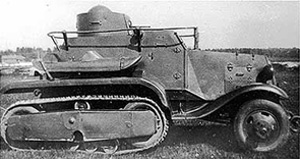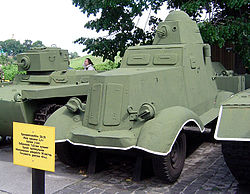This article needs additional citations for verification .(September 2014) |
| BA-30 | |
|---|---|
 | |
| Type | Half-track |
| Place of origin | |
| Service history | |
| Used by | |
| Specifications | |
| Mass | 4.6 tonnes |
| Length | 4.94 m |
| Width | 2.4 m |
| Height | 4.6 m |
| Crew | 3 |
| Armor | 6 mm |
Main armament | DT machine gun (1512 rounds) |
| Engine | GAZ-M1 gasoline engine 50 hp (37 kW) |
| Power/weight | 10.9 hp/tonne [1] |
| Suspension | half track |
Operational range | 253 km |
| Maximum speed | 37 km/h |
The BA-30 was a Soviet half-track armored car developed in 1937. Only a small number were built.
